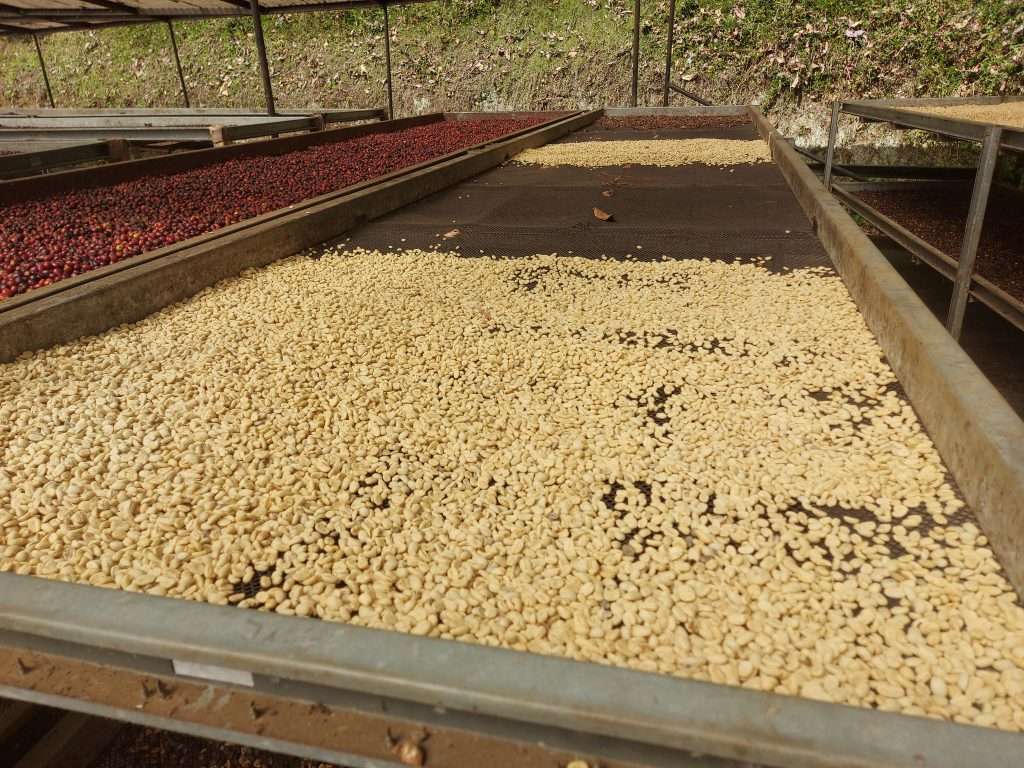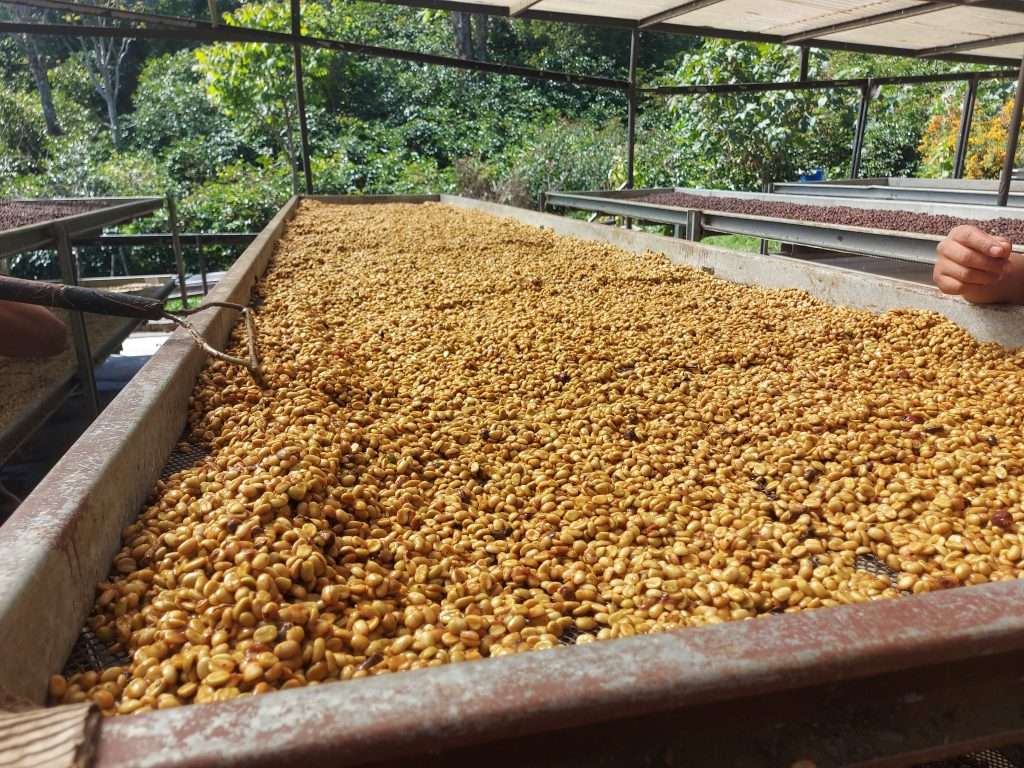Have you ever wondered, “What is coffee natural vs washed vs honey?” Well, the secret lies in the processing. The method chosen – whether natural, washed, or enchanting honey – doesn’t just affect the coffee’s journey from bean to brew; it profoundly influences its flavor and aroma. These intricate processing methods, guided by economics and bean quality, impart unique characteristics to the coffee. For instance, a high-altitude Arabica might undergo wet processing to accentuate its delicate notes. At the same time, a lowland robusta might revel in the natural process of coffee drying, drawing out its earthy tones. As you sip your next brew, remember that the method behind the mug defines the flavors on your palate.

Lamastus Family Estates is where the precious coffee fruit is masterfully turned into the beloved beans we cherish.
What is a coffee processing method?
When you think of a coffee cherry, imagine it having two seeds nestled within. A mesocarp surrounds these seeds, the fleshy part or pulp of the fruit, and a sticky layer called mucilage. Coffee processing focuses on the techniques used to strip away these layers to reveal the seeds, commonly known as coffee beans.
The methods employed in the green bean at this stage are pivotal in shaping the coffee’s final character. They alter the green coffee’s chemical makeup, influencing its sweetness, body, and acidity levels. Getting this right is crucial; even a top-grade coffee cherry can yield an undesirable flavor if processed incorrectly. Around the world, the three mainstay methods are washed, natural, and honey, with the selection often reflecting the traditions, practices, and conditions of the bean’s country of origin.
What are the 3 Main Coffee Processing Methods?
These are the three main ways in which coffee is traditionally processed:
1. Natural Processed Coffee
The “natural” process in coffee is a traditional method that depends mainly on drying the entire coffee cherry after harvest without losing its outer layer. This process requires a suitable climate, ensuring the cherry dries properly during the necessary drying period. This method explores coffee processing, dominant in regions such as Ethiopia, Yemen, and Indonesia, and notably represents 90% of coffee processing in Brazil, it offers a cup profile characterized by low acidity, entire body, and flavors between fruity and vinous notes of great Arabicas—altitude. and the sweet and earthy nuances of the Robustas.

What is the process?
Coffee cherries are first harvested and sorted, and those unripe or contaminated by insects are removed. They are then spread on drying yards or raised African beds and agitated constantly to ensure uniform drying. Drying typically takes 7 to 15 days, although this varies depending on local weather conditions. Ensuring optimal humidity is essential; Overdrying results in brittle beans prone to breaking during grinding, while underdrying risks contamination by fungi or bacteria.
While this method is predominant among coffee producers in many regions, it is often a choice driven by limited resources or when the inherent quality of the coffee does not promise an attractive market price. The simplicity of the method only sometimes equates to high quality, making it a less common option for those who prioritize the grain’s premium characteristics. However, when competently executed under proper conditions, the natural process can produce unique flavor coffee profiles that resonate with many enthusiasts.
2. Washed Coffees

The washed or wet coffee processing method stands out for its meticulous approach to ensuring coffee beans’ clean, pronounced flavor. Preferred for quality coffees, this method leverages water to strip away the fruit’s pulp and mucilage, resulting in beans that exhibit bright acidity and clarity in their flavor profiles. Coffees processed this way often boast a balanced taste, medium body, and sweetness, complemented by that vibrant acidity. This pronounced acidity, characterized by fruity and floral notes, is highly prized in the coffee world, making the washed or wet hulling process a favored choice for many high-quality beans.
The process commences with harvesting mature coffee cherries, which are then subjected to a pulper machine, effectively separating the bean from its surrounding pulp. However, a sticky residue known as mucilage still clings to these beans. To address this, they’re placed in fermentation tanks, where, over 12 to 24 hours, the mucilage undergoes a texture transformation from viscous to rough. This change is aided by bacteria that enhance the coffee’s complex flavors. Once the fermentation process is complete, the coffee beans are thoroughly washed to remove any remaining pulp and then left to dry. Whether on elevated African beds, traditional patios, or efficient industrial dryers, the objective of the dry process remains consistent: achieve an optimal moisture content of around 12.5% to ensure the bean’s quality and flavor longevity.
3. Honey Process
Honey is a coffee cherry drying process in which part of the pulp of that cherry remains in the already processed natural coffee bean, and, in many cases, the coffee bean is covered while it dries.
If you want to buy a honey coffee, you will have three options: Yellow, red, or black, often named Honey Yellow – Honey Red – Honey Black. You will also hear a description of the type of Honey by percentage.

These three colors, yellow, red, and black, are not the only ones but are the most relevant phases in coffee processing using this method.
How is honey-processed coffee?

In essence (and therefore semi-washed), the first stage is the same as the washing process; once the ripe cherries have been collected, they are classified manually or mechanically and taken to the pulper. At this point, the first stage of the Honey process enters since it is vitally important to be extremely careful to leave the most significant layer of mucilage attached to the parchment (the husk that covers the seed).
Once pulped, it goes from the wet process directly to drying instead of fermenting. Given this step, this process is called hybrid in some countries or regions because it mixes the damp mill and part of the dry mill.
Another differentiation from drying beds to the other processes occurs in this step. Here, the days or optimal drying time will be decided according to the type of Honey you want to obtain.
Conclusion
In specialty coffee, though, the processing method – natural, washed, or honey – greatly determines its flavor and aroma. Each technique imparts distinct characteristics, shaping the taste profile of the brew. When you encounter ‘natural,’ ‘washed,’ or ‘honey’ on your coffee package, it provides a clue to the bean’s journey and the flavor nuances. By understanding “What is coffee: natural vs washed vs honey?”, you gain a clearer idea of the flavor profile you can expect, refining your coffee experience with every cup.
FAQs about coffee: natural vs. washed vs honey
1. Is natural or washed coffee better?
Neither is universally “better,” as it largely depends on personal taste preferences. Natural coffees tend to have a fruitier profile due to the cherry drying around the bean, often resulting in wine-like or berry flavors. Washed coffees, on the other hand, often showcase a cleaner profile with pronounced acidity, offering clarity in flavors. The choice between them comes down to whether you prefer a fruit-forward cup or one that highlights the intrinsic flavors of the coffee bean.
2. What is the difference between natural, honey, and washed coffee?
The difference lies in how the sugar content of coffee cherry’s pulp is removed from the bean:
Natural Process: The whole cherry is dried with the bean inside, giving the coffee a fruitier and sometimes wine-like flavor.
The honey process involves removing the skin and pulp of the coffee cherry. However, varying amounts of the mucilage or “honey” remain. Depending on how much mucilage is left, honey-processed coffee can range in flavor from slightly sweet to intensely syrupy.
Washed Process: The cherry’s pulp and mucilage are completely removed before drying. This method produces a clean cup with pronounced acidity, showcasing the bean’s inherent flavors.
3. Is washed coffee organic?
Washed coffee is not organic by default. The term “washed” refers to a method of processing coffee beans, not how they are grown. For coffee to be considered organic, it must be grown without synthetic pesticides and fertilizers and meet the standards for organic farming. Look for an organic certification on the label to ensure the coffee is genuinely organic.
